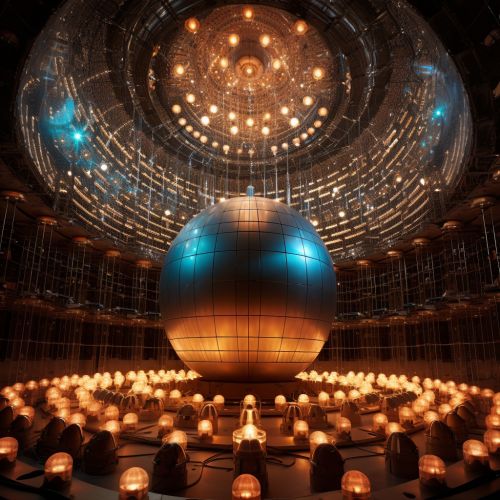Neutrino astronomy
Introduction
Neutrino astronomy is a branch of astronomy that uses neutrinos, subatomic particles produced by nuclear reactions in stars, to understand the universe. Unlike photons, neutrinos can pass through matter without being absorbed or scattered, making them ideal for astronomical observations. This field of study provides unique insights into processes that are difficult to observe using traditional forms of electromagnetic radiation.
Neutrinos
Neutrinos are elementary particles that interact only via the weak subatomic force and gravity. They are electrically neutral, have a small but non-zero mass, and travel close to the speed of light. Neutrinos are produced in large quantities in stars, during nuclear reactions and during supernova explosions. They can pass through normal matter almost undisturbed, making them extremely difficult to detect.
History of Neutrino Astronomy
The concept of neutrino astronomy was first proposed in the 20th century, following the discovery of neutrinos. The first successful detection of neutrinos from an astronomical source occurred in 1987, when neutrinos from Supernova 1987A were observed by multiple detectors around the world. This marked the birth of neutrino astronomy as a viable field of research.
Neutrino Detectors
Neutrino detectors are complex and large-scale devices designed to detect the elusive neutrinos. They are typically located deep underground or underwater to shield them from cosmic rays and other sources of noise. The detectors work by observing the tiny flashes of light produced when a neutrino interacts with a particle in the detector material. Some of the most notable neutrino detectors include the Super-Kamiokande in Japan, the IceCube Neutrino Observatory in Antarctica, and the Sudbury Neutrino Observatory in Canada.


Neutrino Sources
The primary sources of neutrinos are the sun and supernovae. The sun produces neutrinos through nuclear fusion reactions in its core, while supernovae produce neutrinos during the explosive end of a star's life cycle. Other potential sources of neutrinos include active galactic nuclei, gamma-ray bursts, and the decay of dark matter particles.
Neutrino Oscillations
Neutrinos are unique in that they can change their type, or "flavor", as they travel. This phenomenon, known as neutrino oscillation, was first confirmed by the Super-Kamiokande and Sudbury Neutrino Observatory experiments, and earned the 2015 Nobel Prize in Physics. Neutrino oscillations are a key piece of evidence for the existence of neutrino mass, which is not predicted by the Standard Model of particle physics.
Challenges and Future Prospects
Despite significant advancements, neutrino astronomy faces several challenges. The detection of neutrinos is a difficult task due to their weak interaction with matter. Additionally, identifying the exact sources of detected neutrinos remains a challenge. However, the future of neutrino astronomy is promising, with several new detectors planned or under construction. These new instruments will improve our ability to detect and study neutrinos, opening up new avenues for understanding the universe.
